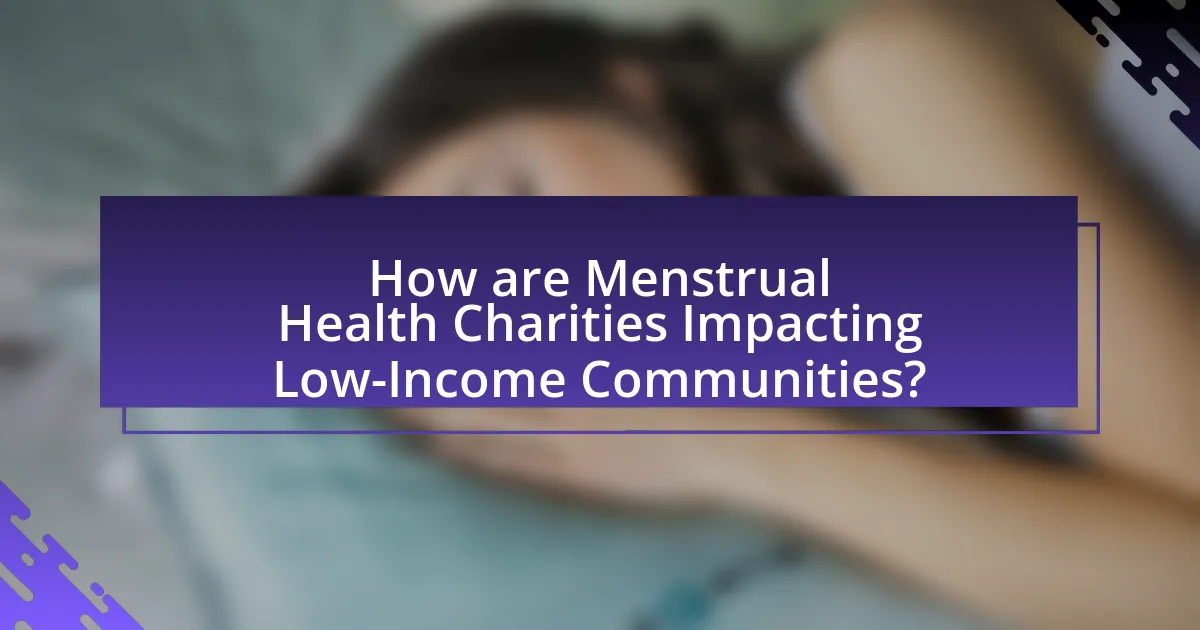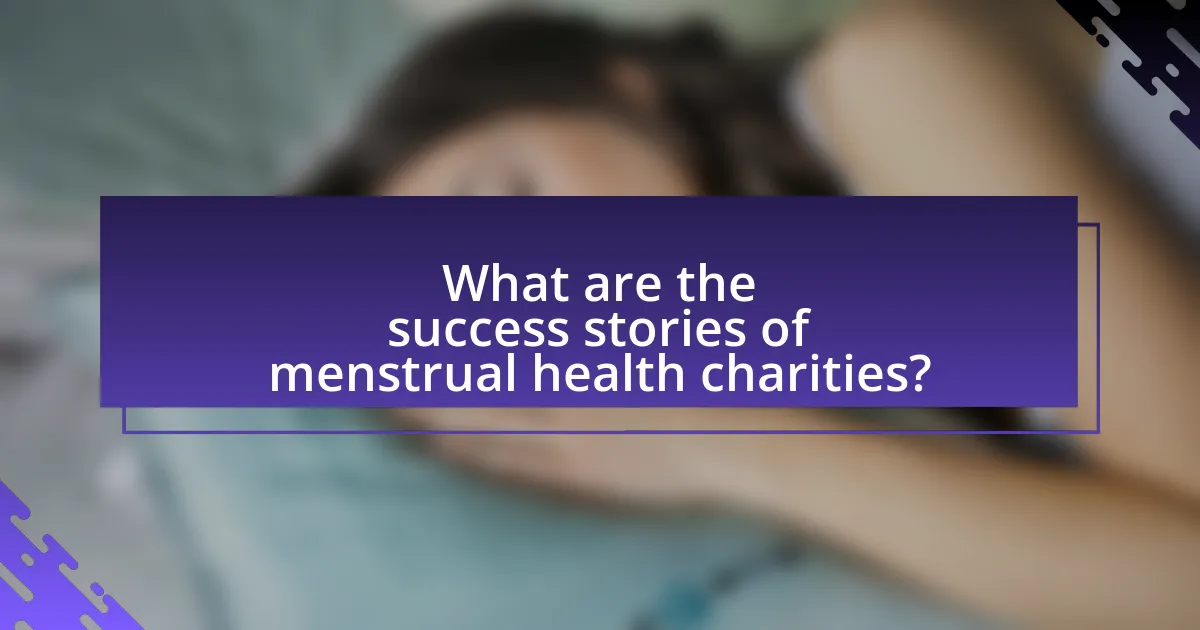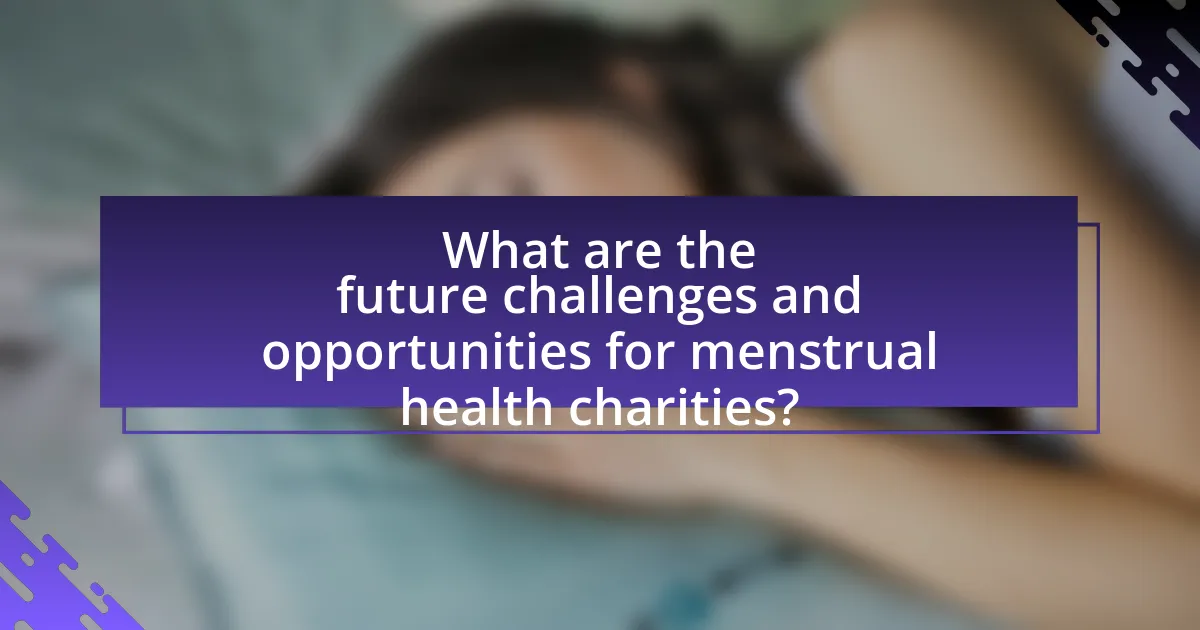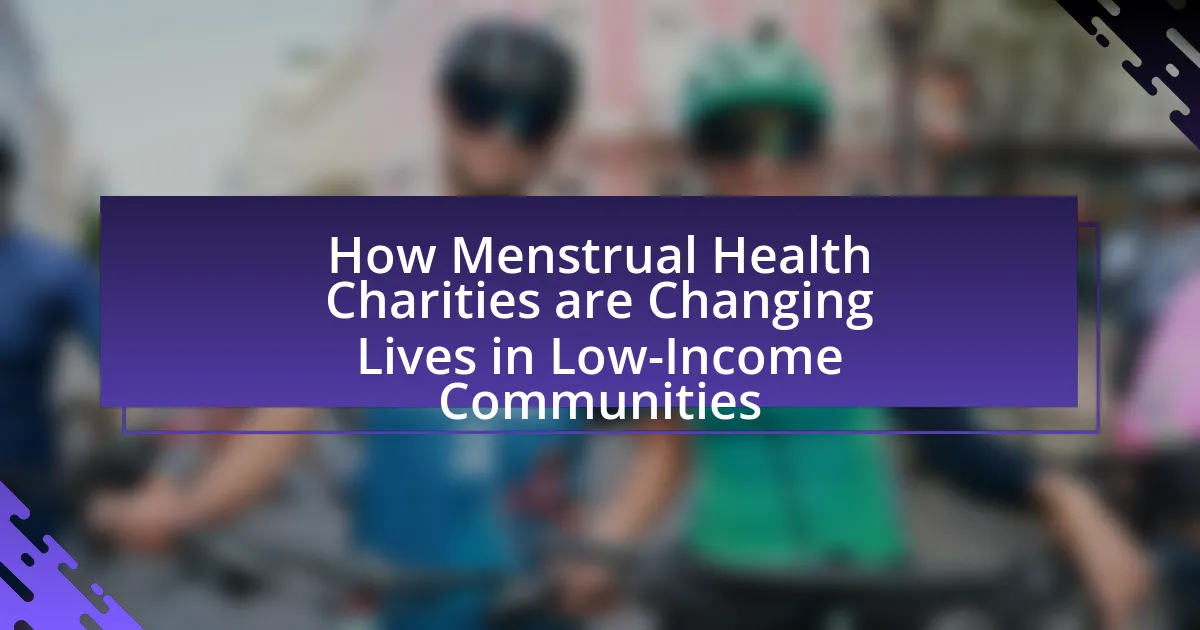Menstrual health charities play a crucial role in transforming the lives of individuals in low-income communities by addressing period poverty through the provision of essential menstrual products and education. These organizations tackle significant challenges such as limited access to affordable menstrual supplies, inadequate education on menstrual hygiene, and cultural stigma surrounding menstruation. By distributing products and conducting educational workshops, these charities not only enhance individual well-being but also contribute to improved educational and economic outcomes. The article explores the specific challenges faced by low-income communities, the essential services provided by these charities, and the measurable impact of their initiatives, highlighting success stories and the importance of community involvement and partnerships in advancing menstrual health.

How are Menstrual Health Charities Impacting Low-Income Communities?
Menstrual health charities are significantly improving the lives of individuals in low-income communities by providing essential menstrual products and education. These organizations address the issue of period poverty, which affects millions of people who cannot afford basic menstrual hygiene products. For instance, a study by the nonprofit organization Period found that 1 in 5 teens in the U.S. have missed school due to lack of access to menstrual products. By distributing free menstrual supplies and offering educational workshops, these charities help reduce stigma, promote health awareness, and ensure that menstruators can manage their periods with dignity. This direct support not only enhances individual well-being but also contributes to better educational and economic outcomes for those in low-income situations.
What specific challenges do low-income communities face regarding menstrual health?
Low-income communities face significant challenges regarding menstrual health, primarily due to limited access to affordable menstrual products, inadequate education about menstrual hygiene, and stigma surrounding menstruation. Research indicates that 1 in 5 girls in the U.S. have missed school due to lack of access to menstrual products, highlighting the impact of financial constraints on education and health. Additionally, many individuals in these communities lack proper knowledge about menstrual health, which can lead to health complications and perpetuate cycles of poverty. Stigma and cultural taboos further exacerbate these issues, discouraging open discussions and access to necessary resources.
How does poverty affect access to menstrual hygiene products?
Poverty significantly restricts access to menstrual hygiene products, as individuals in low-income communities often lack the financial resources to purchase these essential items. Research indicates that in many developing countries, up to 50% of women and girls cannot afford menstrual products, leading to the use of unsafe alternatives or the inability to manage menstruation effectively. This lack of access can result in health issues, social stigma, and absenteeism from school or work, further perpetuating the cycle of poverty. For instance, a study by the Water Supply and Sanitation Collaborative Council found that inadequate menstrual hygiene management can lead to increased school dropout rates among girls, highlighting the broader implications of poverty on menstrual health.
What cultural stigmas exist around menstruation in these communities?
Cultural stigmas around menstruation in low-income communities often include beliefs that menstruating individuals are impure or unclean, leading to social exclusion and restrictions on daily activities. For instance, in some cultures, menstruating women may be forbidden from entering places of worship or participating in community events, which reinforces feelings of shame and isolation. Additionally, misinformation about menstruation can perpetuate myths, such as the idea that menstruating individuals should avoid certain foods or physical activities, further complicating their health and well-being. These stigmas can hinder access to menstrual health resources and education, exacerbating the challenges faced by individuals in these communities.
Why are menstrual health charities essential in these areas?
Menstrual health charities are essential in low-income communities because they provide critical access to menstrual products, education, and health services. These charities address the stigma and barriers surrounding menstruation, which can lead to school absenteeism and health issues. For instance, research indicates that girls in low-income areas often miss up to 20% of school days due to lack of menstrual supplies, directly impacting their education and future opportunities. By supplying products and promoting awareness, these charities empower individuals, improve health outcomes, and foster gender equality.
What services do these charities provide to address menstrual health issues?
Charities addressing menstrual health issues provide services such as education on menstrual hygiene management, distribution of menstrual products, and advocacy for policy changes. These organizations often conduct workshops to inform communities about menstrual health, aiming to reduce stigma and improve knowledge. For instance, some charities distribute reusable sanitary products, which can significantly lower costs for low-income families and promote sustainability. Additionally, they may engage in advocacy efforts to influence legislation that ensures access to menstrual products in schools and public facilities, thereby addressing systemic barriers to menstrual health.
How do these charities raise awareness about menstrual health?
Charities raise awareness about menstrual health through educational campaigns, community workshops, and social media outreach. These initiatives aim to inform individuals about menstrual hygiene management, dispel myths, and promote open discussions surrounding menstruation. For instance, organizations like Days for Girls provide educational materials and training sessions, reaching over 1 million girls globally, which highlights the effectiveness of direct engagement in raising awareness. Additionally, social media platforms amplify their messages, allowing for broader reach and engagement, as evidenced by campaigns that have garnered millions of views and shares, thus increasing public discourse on menstrual health issues.

What are the success stories of menstrual health charities?
Menstrual health charities have successfully improved access to menstrual products and education in low-income communities, significantly enhancing the quality of life for many individuals. For instance, the charity Days for Girls has distributed over 1.5 million menstrual kits in more than 100 countries, enabling girls to attend school during their periods, which has been shown to increase school attendance rates by up to 20%. Another example is the organization Period, which has provided menstrual products to over 1 million individuals in the United States, addressing period poverty and raising awareness about menstrual health issues. These initiatives demonstrate the tangible impact of menstrual health charities in promoting health equity and empowering marginalized communities.
How have specific charities made a difference in communities?
Menstrual health charities have significantly improved the lives of individuals in low-income communities by providing access to menstrual products, education, and health services. For instance, organizations like Days for Girls and The Pad Project distribute reusable menstrual kits and offer workshops that educate women and girls about menstrual hygiene management. These initiatives have led to increased school attendance among girls, with studies indicating that access to menstrual products can reduce absenteeism by up to 20%. Furthermore, these charities advocate for policy changes that promote menstrual health awareness, contributing to a broader societal understanding of menstrual issues and reducing stigma.
What measurable outcomes have been observed from their initiatives?
Menstrual health charities have observed significant measurable outcomes from their initiatives, including increased school attendance among girls, improved health awareness, and enhanced access to menstrual products. For instance, a study by the Global Menstrual Health Coalition found that programs providing menstrual hygiene management education and supplies led to a 20% increase in school attendance for girls in low-income communities. Additionally, surveys indicate that 75% of participants reported improved knowledge about menstrual health, demonstrating the effectiveness of educational initiatives. These outcomes highlight the positive impact of menstrual health charities on the lives of individuals in underserved areas.
How do personal testimonies highlight the impact of these charities?
Personal testimonies highlight the impact of menstrual health charities by providing firsthand accounts of how these organizations improve lives in low-income communities. Individuals often share experiences of gaining access to menstrual products, education, and healthcare, which directly correlates with increased school attendance and improved health outcomes. For instance, a study by the Global Menstrual Health Coalition found that girls who received menstrual hygiene management support were 30% more likely to attend school during their menstrual periods. These narratives not only illustrate the tangible benefits of the charities’ work but also emphasize the emotional and social empowerment that comes from breaking the stigma surrounding menstruation.
What partnerships enhance the effectiveness of menstrual health charities?
Partnerships with healthcare providers, educational institutions, and local governments enhance the effectiveness of menstrual health charities. These collaborations enable charities to access resources, expertise, and networks that facilitate comprehensive menstrual health education and services. For instance, partnerships with healthcare providers allow charities to offer medical support and accurate information about menstrual health, while collaborations with educational institutions help integrate menstrual health education into school curricula, reaching young people directly. Additionally, working with local governments can lead to policy changes that improve access to menstrual products and health services, thereby addressing systemic barriers faced by low-income communities.
How do collaborations with local organizations improve outreach?
Collaborations with local organizations improve outreach by leveraging established community trust and networks. When menstrual health charities partner with local entities, they gain access to a wider audience and can effectively disseminate information tailored to the specific needs of the community. For instance, a study by the Global Health Council found that community-based partnerships can increase program participation by up to 50%, as local organizations often have insights into cultural sensitivities and logistical challenges. This localized approach ensures that outreach efforts are more relevant and impactful, ultimately enhancing the effectiveness of menstrual health initiatives in low-income communities.
What role do government and private sector partnerships play?
Government and private sector partnerships play a crucial role in enhancing menstrual health initiatives in low-income communities by combining resources, expertise, and outreach capabilities. These collaborations enable the development and distribution of affordable menstrual products, educational programs, and health services, addressing the stigma and barriers associated with menstrual health. For instance, partnerships between NGOs and local governments have led to the implementation of community-based programs that provide menstrual hygiene education and access to sanitary products, significantly improving the health and well-being of women and girls. Such initiatives have been shown to increase school attendance among girls, as evidenced by studies indicating that access to menstrual products can reduce absenteeism by up to 20%.

What are the future challenges and opportunities for menstrual health charities?
Future challenges for menstrual health charities include addressing stigma and cultural taboos surrounding menstruation, which can hinder outreach and education efforts. Additionally, securing sustainable funding remains a critical issue, as many charities rely on donations and grants that can fluctuate. Opportunities for these charities lie in leveraging technology for awareness campaigns and education, as well as forming partnerships with local organizations to enhance community engagement. For instance, the global market for menstrual products is projected to reach $6.2 billion by 2025, indicating a growing recognition of menstrual health, which charities can capitalize on to expand their initiatives.
What barriers do these charities face in expanding their reach?
Menstrual health charities face several barriers in expanding their reach, including limited funding, cultural stigma, and logistical challenges. Limited funding restricts the ability of these organizations to scale their programs and outreach efforts, as evidenced by a report from the Global Fund for Women, which highlights that many charities operate on tight budgets that hinder their capacity to serve more communities. Cultural stigma surrounding menstruation often leads to a lack of awareness and support, making it difficult for charities to engage with local populations effectively. Additionally, logistical challenges such as transportation issues and inadequate infrastructure in low-income areas complicate the distribution of menstrual health products and education, as noted in a study by the United Nations Population Fund, which emphasizes the importance of addressing these barriers to improve access to menstrual health resources.
How can funding limitations affect their operations?
Funding limitations can severely restrict the operations of menstrual health charities, leading to reduced program effectiveness and outreach. These financial constraints often result in fewer resources for educational initiatives, limited access to menstrual products, and diminished capacity to support community engagement efforts. For instance, a study by the Menstrual Health Alliance found that organizations with inadequate funding could only reach 30% of their target populations, significantly impacting their ability to provide essential services. Consequently, funding limitations directly hinder the charities’ mission to improve menstrual health and hygiene in low-income communities.
What strategies can be implemented to overcome these challenges?
To overcome challenges in menstrual health in low-income communities, menstrual health charities can implement educational programs that raise awareness about menstrual hygiene management. These programs can provide accurate information on menstruation, dispel myths, and promote healthy practices, which is essential as studies show that education significantly improves menstrual health outcomes. Additionally, charities can establish partnerships with local organizations to distribute menstrual products, ensuring accessibility for those in need. Research indicates that access to sanitary products can reduce school absenteeism among girls, highlighting the importance of product distribution initiatives. Furthermore, advocating for policy changes to include menstrual health in public health agendas can create systemic support for these initiatives, as evidenced by successful campaigns in various countries that have led to increased funding and resources for menstrual health programs.
How can individuals support menstrual health charities effectively?
Individuals can support menstrual health charities effectively by donating funds, volunteering time, and raising awareness about menstrual health issues. Financial contributions enable charities to provide essential products and services to those in need, while volunteering helps organizations operate more efficiently and reach more individuals. Additionally, raising awareness through social media or community events can educate others about the importance of menstrual health, thereby increasing support and resources for these charities. According to a report by the Menstrual Health Alliance, increased awareness can lead to a 30% rise in donations and volunteer participation, demonstrating the impact of individual efforts on the success of menstrual health initiatives.
What are the best practices for donating to these organizations?
The best practices for donating to menstrual health charities include researching the organization’s mission, financial transparency, and impact metrics. Donors should ensure the charity is registered and has a proven track record of effectively using funds to improve menstrual health in low-income communities. According to the National Philanthropic Trust, organizations that provide clear financial reports and demonstrate measurable outcomes are more likely to utilize donations efficiently. Additionally, donors should consider recurring donations to provide sustained support, as consistent funding helps charities plan long-term initiatives.
How can community involvement amplify the impact of these charities?
Community involvement can amplify the impact of menstrual health charities by fostering local ownership and increasing resource mobilization. When community members actively participate in initiatives, they contribute valuable insights into the specific needs and cultural contexts of their peers, leading to more effective and tailored interventions. For instance, a study by the Menstrual Health Hub found that community-led programs in low-income areas resulted in a 30% increase in awareness and access to menstrual health resources compared to top-down approaches. This local engagement not only enhances the relevance of the services provided but also encourages sustained support and advocacy, ultimately leading to improved health outcomes and empowerment for women and girls in these communities.



